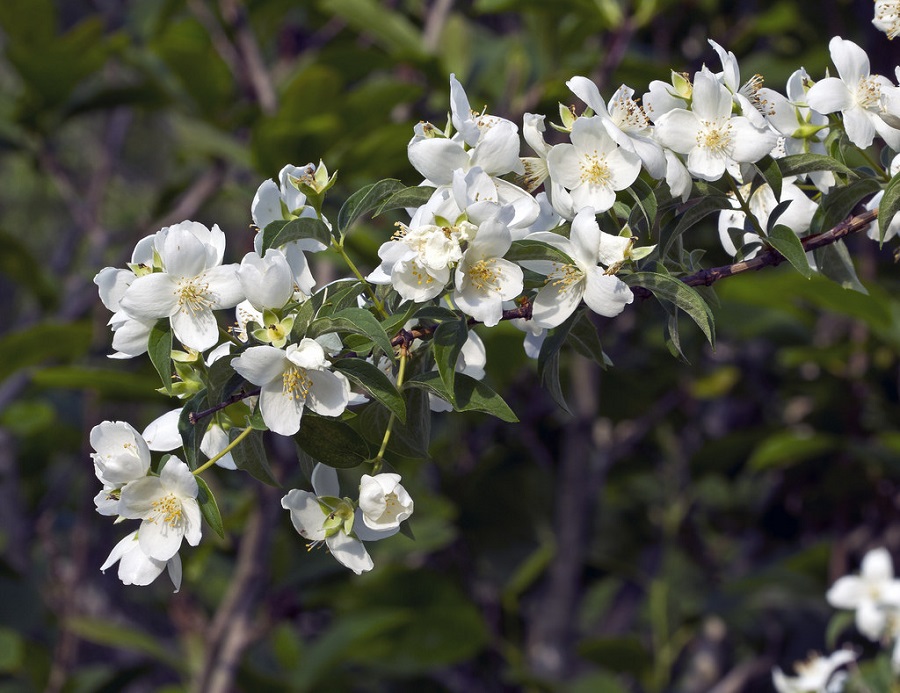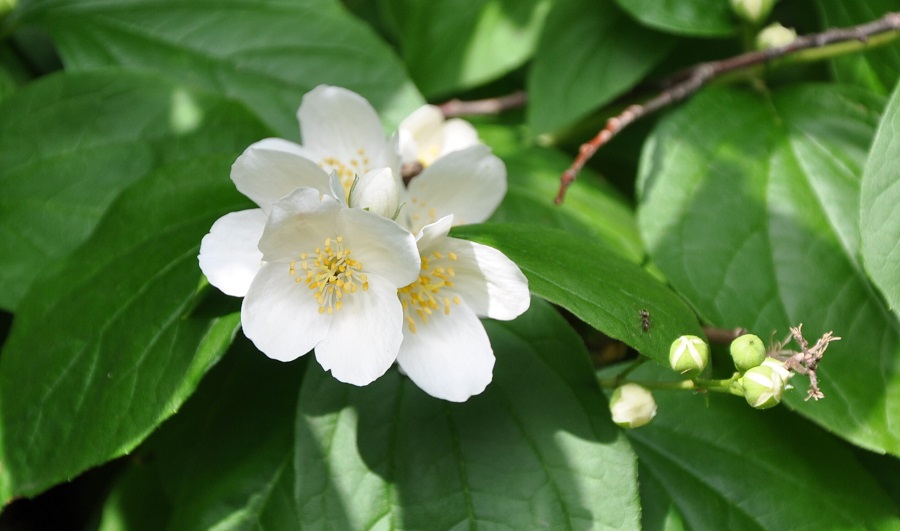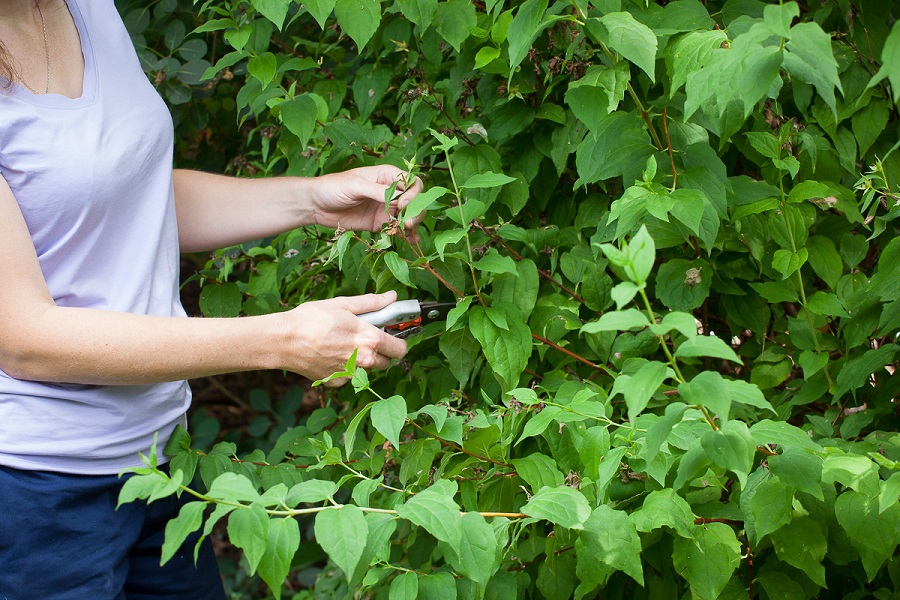Fiorellini Bianchi Di Gelsomino - Varietà, Potatura, Propagazione e Cura
Fiorellini Bianchi Di Gelsomino (Philadelphus) è un arbusto da giardino facile da coltivare. Non è una pianta esigente: per questo motivo è perfetta per tutti i giardinieri, indipendentemente dalla loro esperienza. Grazie alla sua crescita rapida e alla sua larghezza, insieme ai suoi fiori straordinariamente profumati, è un elemento decorativo comune nei giardini. Scoprite di cosa ha bisogno un Fiorellini Bianchi Di Gelsomino e conoscete le sue varietà. Rinfrescate il vostro giardino.

Fiorellini Bianchi Di Gelsomino: che tipo di pianta è e che aspetto ha?
Fiorellini Bianchi Di Gelsomino, o Philadelphus coronarius, è una pianta delle hydrangeaceae. Molte persone lo confondono con il gelsomino, ma non si tratta della stessa specie. Esistono oltre 70 varietà di questa pianta. Cresce naturalmente in Turchia, nel Caucaso e nelle isole dell’Egeo, ma è presente anche in Italia e nelle regioni meridionali dell’Australia.
A seconda della varietà, il Fiorellini Bianchi Di Gelsomino può crescere fino a 3 metri di altezza. È caratteristico per la sua rapida crescita e per il suo portamento ampio. I suoi rami giovani sono dritti e si piegano gradualmente con l’età. Le foglie del Fiorellini Bianchi Di Gelsomino raggiungono gli 8 centimetri di lunghezza.
I fiori a quattro petali bianco e crema sono un’attrazione indiscutibile di questa pianta. I grandi fiori che crescono su questo arbusto sviluppano una magnifica fragranza durante la stagione della fioritura. Quindi, questo cespuglio ornamentale non è solo una bella decorazione del cortile, ma anche una delizia olfattiva per chiunque passi di lì.

Le varietà di Fiorellini Bianchi Di Gelsominopiù popolari
Le Fiorellini Bianchi Di Gelsomino sono disponibili in oltre una dozzina di varietà diverse. Ma in realtà sono tre le varietà più popolari e più interessanti conosciute in tutto il mondo. Si tratta di:
- Aureus - foglie dorate e fiori bianchi dal profumo intenso sono le sue caratteristiche principali,
- Dwarf mock orange - questa varietà sviluppa un’abbondanza di fiori rispetto ad altri tipi e ha caratteristiche foglie ondulate,
- Variegata - le foglie doppie di colore verde e bianco sono la caratteristica di questa varietà.
I Fiorellini Bianchi Di Gelsomino dolce hanno bisogno di un terreno speciale per crescere?
Fiorellini Bianchi Di Gelsomino è molto facile da coltivare e non ha esigenze particolari. Quando si sceglie una posizione per questo cespuglio, scegliere un luogo in pieno sole. In questo modo la pianta può fiorire meglio. Anche un Philadelphus piantato in un luogo ombreggiato cresce bene, ma non aspettatevi una fioritura abbondante da questa pianta.
L’arbusto cresce meglio in un terreno argilloso con livelli di umidità moderati. Il pH può essere leggermente alcalino o leggermente acido. Se non avete esperienza di giardinaggio, potete usare una miscela di terriccio acquistata in un negozio di giardinaggio per ottenere il livello di pH corretto.

Il Fiorellini Bianchi Di Gelsomino: qual è il suo tasso di crescita?
Fiorellini Bianchi Di Gelsomino è un arbusto a crescita rapida. Raggiunge le dimensioni massime in un tempo relativamente breve. Per controllare le dimensioni della pianta, bisogna ricordarsi della potatura regolare.
Molte persone apprezzano il rapido tasso di crescita e la forma ampia della pianta, in quanto queste caratteristiche possono essere molto vantaggiose. Grazie a queste caratteristiche, la pianta viene spesso utilizzata come arbusto da siepe o come pianta da corsia. Grazie a ciò, si può trovare riparo alla sua ombra.
Quando piantare i Fiorellini Bianchi Di Gelsomino?
L’autunno è la stagione migliore per piantare Fiorellini Bianchi Di Gelsomino. Prima di piantare il cespuglio in un determinato luogo, immergere la zolla di terra in acqua. Assicuratevi di smuovere il terreno in cui crescerà il Philadelphus e di rimuovere eventuali erbacce.
La buca per il cespuglio deve essere almeno due volte più grande della sua zolla. In questo modo le radici avranno spazio sufficiente per espandersi e potrete essere certi che il cespuglio attecchirà.
Fiorellini Bianchi Di Gelsomino, una delle varietà dell’arbusto, ha bisogno di una preparazione simile prima di essere piantato.

Fiorellini Bianchi Di Gelsomino - annaffiatura e concimazione
Un Fiorellini Bianchi Di Gelsomino appena piantato richiede molta acqua. Evitate di lasciare che il terreno si asciughi completamente o che l’acqua rimanga nel terreno. Entrambe le situazioni sono ugualmente pericolose.
Il Fiorellini Bianchi Di Gelsomino è un arbusto piuttosto esigente per quanto riguarda le sue esigenze nutrizionali. La concimazione dell’arbusto con materiale organico è particolarmente importante, soprattutto dopo aver piantato i giovani Fiorellini Bianchi Di Gelsomino. Le piante più vecchie devono essere nutrite una volta all’anno, ogni primavera.
Evitate i fertilizzanti ad alto contenuto di azoto. Un’alta concentrazione di questo ingrediente fa crescere bene la pianta, ma senza fiori.
Come propagare un cespuglio di Fiorellini Bianchi Di Gelsomino?
Il Philadelphus è una pianta facile da propagare. Potete scegliere tra due metodi, quello più semplice per voi.
- Il recupero delle talee verdi direttamente dal cespuglio in estate è uno dei metodi più diffusi.
- Un altro metodo prevede l’utilizzo di talee legnose recuperate in inverno.
Per velocizzare l’intero processo, si può utilizzare l’ormone radicante. Per ottenere le migliori condizioni di crescita, collocate le talee in vasi riempiti di terriccio.

Potatura del Fiorellini Bianchi Di Gelsomino: è indispensabile?
Alcuni arbusti richiedono una potatura regolare se si vuole tenerli sotto controllo: questo vale anche per i Fiorellini Bianchi Di Gelsomino. La potatura dell’arbusto è consigliata se si vuole correggere la sua crescita e dargli una forma particolare.
- La prima potatura dovrebbe essere effettuata entro i primi 3-4 anni di vita della pianta.
- Eventuali tagli correttivi devono essere eseguiti dopo la fine della fioritura.
- La potatura di ringiovanimento è riservata all’autunno e all’inverno, quando la pianta perde le foglie.
Fiorellini Bianchi Di Gelsomino - malattie più comuni
Gli Fiorellini Bianchi Di Gelsomino sono vulnerabili a diverse malattie. Una di queste è la macchia delle foglie. La malattia compare di solito sul cespuglio alla fine dell’estate. È allora che si notano delle macchie marroni sulle foglie. Le foglie diventano secche nel punto in cui sono comparse le macchie e iniziano a sbriciolarsi, lasciando dei buchi. I fertilizzanti speciali contro le macchie sono la soluzione migliore: si possono acquistare nei negozi di giardinaggio.
Il cespuglio è anche vulnerabile alla botrite. La malattia si diffonde particolarmente bene durante un’estate piovosa. La malattia attacca i petali dei fiori, che diventano neri e ricoperti di residui polverosi.
Le Fiorellini Bianchi Di Gelsomino sono vulnerabili ai parassiti?
Per quanto riguarda i parassiti, gli afidi neri del fagiolo sono la minaccia maggiore per le arance finte. Questo tipo di afidi che compare sull’arbusto deforma le foglie del Philadelphus e le ricopre di un residuo appiccicoso. Per sbarazzarsi di questo parassita sono necessari spray speciali. Si consiglia di provare quelli naturali e, se non funzionano, di utilizzare prodotti chimici.

📍 Che aspetto ha una Fiorellini Bianchi Di Gelsomino?
Fiorellini Bianchi Di Gelsomino è un arbusto decorativo. Il suo portamento ampio è la sua caratteristica. A seconda della varietà, può crescere da 1 a 3 metri di altezza. Ha un profumo dolce e molto intenso diffuso dai fiori bianchi e crema.
📍 Il Fiorellini Bianchi Di Gelsomino cresce velocemente?
Il Fiorellini Bianchi Di Gelsomino cresce molto velocemente. Per controllare la sua crescita, bisogna potarlo regolarmente. In questo modo è possibile dargli una forma particolare.
📍 Come propagare un Fiorellini Bianchi Di Gelsomino?
La propagazione delle Fiorellini Bianchi Di Gelsomino non è una sfida per il giardiniere. Utilizzate talee semiverdi raccolte in estate, ad esempio a luglio. È anche possibile utilizzare talee legnose raccolte in inverno.
📍 Quando fioriscono le Fiorellini Bianchi Di Gelsomino?
La fioritura delle Fiorellini Bianchi Di Gelsomino avviene in diversi mesi, a seconda della varietà. In genere, però, avviene all'inizio di maggio e all'inizio di giugno.
Articoli in primo piano




